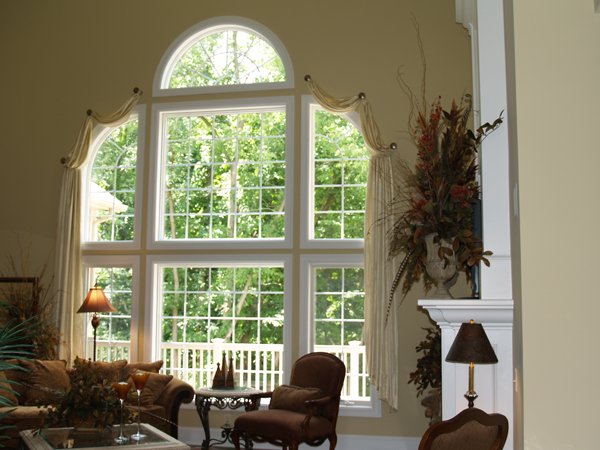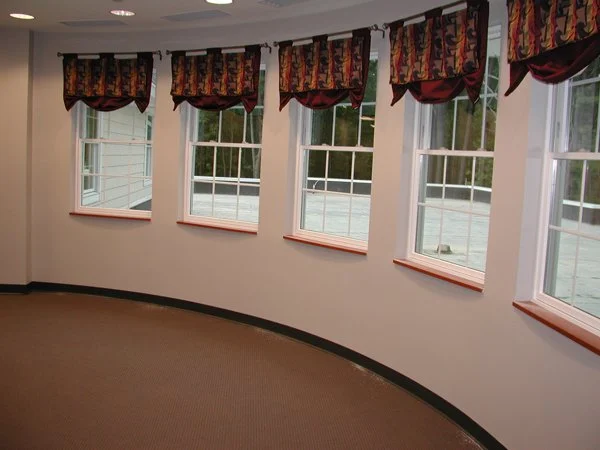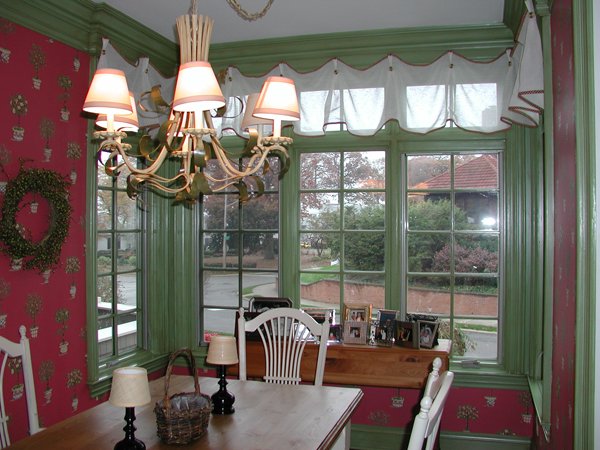Window Styles
-

Arch Top Windows
A semicircular window that is usually placed above a rectangular window. The arch can be presented in many different forms: It can have straight sides, be a quarter of a circle, or it can be elongated or eyebrow shaped. Sometimes there are rectangular windows on either side that do not have arches above them. They are also called Palladian windows, half moons, or half rounds. These windows can be challenging, although they are one of Well Dressed Windows’ specialties. Oftentimes we hang decorative medallions that follow the shape of the arch and “droop” the panels at the top between the medallions to form a casual, but sophisticated look.
-

Bay Windows
Bay windows consist of three (or five) windows at an angle that project out from the home. Often the center window is twice as wide as the two side windows. Sometimes bay windows go all the way up to the ceiling and at other times there is a soffit above them. Also, sometimes there is a seat below the windows in the protruded area. There often is little wall space between and/or above bay windows, so bays are another challenging window to dress. Styles that are mounted on a fabric covered board that can be mitered to fit into the angles of the bay are an ideal solution. Mounting draperies on a rod can be achieved, although it is more difficult.
-

Bow Windows
Similar to bay windows, but the windows form a soft curve instead of angles. The easiest, although not the only way, to handle these windows is to treat each window individually.
-

Casement Windows
Windows that are hinged on the sides and swing out with a crank to open and close them. When putting blinds or shades on these windows, we can provide T handles to replace the window cranks that get in the way. There is no limit as to what type of fabric treatments can be used on these windows.
-

Dormer Windows
Windows that protrude from the roofline and are boxed out. Often there is little or no wall space on either side or above the windows making these windows difficult to dress. Anything other than a minimal treatment will cover too much of these windows, blocking the view and light.
-

Double Hung Windows
Sash windows where the lower window can be raised and the upper window can be lowered. There is no limit as to what type of fabric treatments can be used on these windows.
-

French Doors
A pair of doors that typically they open into the room, but they may also open outwards. Often one of the two doors is stationary. The challenge associated with these windows is to treat them and to also be able to fully open the doors onto one another. Often blinds and shades can be mounted on them with hold down brackets on the bottom so that they do not sway when the door is opened. Another option is to put individual valances or roman shades on each of the doors. A third option is to mount a drapery treatment that goes beside and above the doors, allowing them full functioning.
-

Ranch Windows
Often found in ranch homes. They are wide windows that are not very tall. While very functional, the proportion of these windows makes them challenging to dress.
-

Sidelights
Tall and narrow windows next to doors. If privacy is not an issue, they can be left uncovered. A typical covering for sidelights is curtains that are gathered and stretched with a rod on the top and a rod on the bottom. A more creative solution that we like is designer window film. It has the look of stained glass, but can be installed for a fraction of the price. The styles are unlimited – from traditional to very contemporary.
-

Single Hung Windows
Sash windows where only the lower window is operable. The top window is fixed. There is no limit as to what type of fabric treatments can be used on these windows.
-
Skylights
Windows in the roofline that are strictly for light, although some do offer the feature of being operable. At times they let in too much light and need to be tinted or covered with a blind.
-

Sliding Glass Doors
Two or three doors with one or more panels sliding to the side rather than opening on hinges. Vertical blinds are often used here. However, if you are not a lover of vertical blinds, there are many other options. Draperies that are either hand or cord traversing are an option. Hunter Douglas has many other products that can be used here –Cadence Soft Verticals, Duette Vertiglide, Luminette Privacy Sheers and Modern Draperies, Skyline Gliding Window Panels, and Vignette Vertiglide. In addition, shutters can be installed that are either bi-fold or bi-pass.
-

Transom Windows
A short window placed over a regular window or door, separated by trim or wall. Its primary purpose is to bring additional light into the room, but high enough up that it usually does not need to be covered for privacy. Sometimes called clerestory windows. There are many options for dressing these windows. We usually like to mount draperies and valances above the transom window, rather than below it to give additional height, although it is not necessary.
